Art inspired by Gaelic mythology and folklore | Shop: https://www.redbubble.com/people/Forfeda | Original art: #forfedaproject
Last active 4 hours ago
Don't wanna be here? Send us removal request.
Note
I was able to snag a copy from an academic friend of mine, but sadly I'm not aware of any place that has it available to read without credentials. Seems to be typical for Carey articles unfortunately.
I am extremely interested in the Morrighan but as I'm sure you're aware it is incredibly difficult to get much information on her. Do you have any sources I could explore or tips on how to tell what is bs?
My best recommendation, frankly, is to start with the myths. The Cattle Raid of Cooley (Táin Bó Cuailnge), The Cattle Raid of Regamna (Táin Bó Regamna), and The Second Battle of Moytura (Cath Maige Tuired) in particular are good places to start. The Morrigan plays a critical role in all three of them. Getting a foundation in what the myths do say about the Morrigan means that you can also understand what the myths don't say, which is critical for spotting misinformation.
For more analytical sources, the Story Archaeology Podcast (which is just generally excellent) has two episodes exclusively looking at the Morrigan and her mythic appearances, and Celticist John Carey has an article called Notes on the Irish War-Goddess that goes into the various Morrigans, if you're able to find it anywhere (and if you do, let me know - I've been trying to track down a copy!).
If you're approaching things from a polytheist standpoint, I've heard good things about the Coru Cathubodua Priesthood, although I haven't had any direct experience with them myself. They do, however, have an excellent reading list.
Ultimately, the Morrigan is one of the most complicated figures in Irish myth, so there's a lot of uncertainty and a lot of conflicting theories. I'd be very wary of any sources that aren't upfront about that.
Good luck!
55 notes
·
View notes
Text

The Tale of Mac Da Thó's Pig is equally about a hound, Ailbe, coveted by the rulers of both Connacht and Ulster. To avoid offending either party by refusing them posession of the magnificent dog, its owner, Mac Da Thó, invites both royal companies to a feast of the titular pig at his hostel, where boasting and quarrelling breaks out among the warriors to a bloody end... This is another entry into my series of pub-sign-style logos for the mythological Irish bruidne, this time featuring both the pig and the hound from the tale, as well as a reference to the cauldrons and flesh-forks that serve as the hostel's signature offering.
#celtic#celticart#mythology#irish mythology#celtic mythology#folklore#bruiden#mac da tho#mac datho#mac da tho's pig#gaelpol#pagan#pagan art#graphic design#forfedaproject
15 notes
·
View notes
Note
Do you still have a shop I can’t find the link?
I do! I've been having some issues with my website redirect, so unfortunately that's still offline, but you can find the shop on Redbubble!
4 notes
·
View notes
Text

THE LIVES OF ÉTAÍN
This piece depicts the themes and symbols around the character of Étaín from Tochmarc Étaíne and her various transformations throughout the tale. The two faces depict Étaín's two incarnations a thousand years apart, flanked by suns and moons to represent that "all time is made up of days and nights." The swan and fly represent Étaín's two animal forms, while the cup and pitcher represent the cup of the wife of Étar, and Étaín's skill at serving drink, by which Eochaid seeks to recognize her. Finally, the vegetation and swirling billows on the outside of the frame symbolize the "fragrant and wonderous herbs" of Aengus's crystal sun-bower, and Fuamnach's magical winds. This was my submission to the late Ralph Kenna's EÍRÍ art project through the Irish Post in 2022, based on the prompt of Evoking Ireland's Resiliant Female Icons. The Wooing of Étaín is one of my favorite Irish myths, and I've always wanted to take a crack at representing some of the themes of the story. Hello everyone, it's been quite a while! I've been on a bit of an impromptu hiatus due to general life stuff and a bit of artistic burnout in the last year or so, but I've got a few works in progress that I'm hoping will help get me back into the swing of things!
#celtic#celticart#mythology#irish mythology#celtic mythology#folklore#etain#midir#aengus#aengus mac og#tochmarc etaine#gaelpol#pagan#pagan art#goddess#forfedaproject
79 notes
·
View notes
Note
Appreciate the shoutout!
also a good reminder to upload my Bricrenn piece with the corrected grammar finally lol
Dia duit! Do you happen to know of any other blogs about Irish culture and language that aren't racist about it?
Dia is Muire Duit!
Embarrassingly, I don’t interact with all that many other people who do this sort of thing, mainly for 3 reasons:
(1) Professional distancing -- Small field, everyone knows each other, which means that if I find anyone or anyone finds me, there’s a not-small chance that we know one another IRL. There’s a reason my palms get a little sweaty when I think about new people coming into Tumblr, and a solid portion of that’s that I don’t want....too much attention on what I do here and, especially, not on my main. (Which I know is the equivalent of holding up a meat stick to a bunch of dogs and going “DO YOU WANT THE MEAT STICK?”) I can’t really vent about my department on main anymore simply because, even though names aren’t attached to things, it’s ridiculously easy to narrow me down if you know what to do. I don’t think I’m doing anything wrong, but there’s a difference between Me On Here VS Me in a Professional Context, and it’s been difficult to try to make that sort of...shift from being a shitposting teenager to suddenly being an Academic™. (But also, I don’t want people to think I’m unapproachable, either -- rule of thumb is “Mutually Assured Destruction.” You know I’m on Tumblr, I know you’re on Tumblr, and we both never mention it.)
(2) Wanting to distance myself a little from what I do Every Day -- Posting on here and interacting with people who are willing to seek me out on here is fine, I like that, I enjoy doing it, I enjoy everyone who follows me, but it’s much more on my terms here. (Hence the inconsistent posting schedule.) When I was younger, before this was my job, I could be around it constantly, and it was a lot of fun, but now it’s like....it’s a Lot, now that it’s my actual life. I check in on the Irish Mythology tag every once in a while, but I can’t really follow it like I used to just because it’s this constant state of *engagement* for me, in a way that, say, French musicals that three people in the world like don’t have.
Brain tired, brain needs nappy.
(3) I’ve seen some people on here, when I’ve looked into blogs to follow be....well. Bitches. Especially re: Americans taking this on and, as an American myself who is very serious about my line of work, it does. Rather sting. (I have a lot of complex opinions on the whole business that I won’t get into now, but the tldr is that I get why people can be hesitant, especially with the borderline fetishization of Ireland in the States but, at the same time, the effect is often scaring people who have a genuine interest in this sort of thing away and, when it comes to an endangered language....the more people we have taking the time to learn it, the better.) (But also, if you imply that my degree, which I got from an *Irish* uni is worthless, the claws will come out. I made a lot of sacrifices for that....glorious....piece of poster board in Latin.)
BUT. BUT.
I do have a few. I want to emphasize that these aren’t all the Good People who do Irish Things on Tumblr, these are just the ones, off the top of my head, I can think of.
@trans-cuchulainn Excellent resource on the Ulster Cycle, A+ shitposts
@finnlongman Another Ulster Cycle specialist
@ad-ciu A former colleague and friend of mine, one of the only human beings in the world I trust with Mythological Cycle content. Not on as much these days because they’re doing things like “schoolwork” and “having a life” and “getting a PhD”, but genuinely a wonderful person to follow so you can catch when they do post.
@amylouioc Wonderful artwork inspired by medieval Irish lit, explicitly anti-racist, multicultural Tuatha Dé, Nuada is a snacc.
@forfeda-project Another A+ art blog, am considering getting their pub shirt for Fled Bricrenn to wear at conferences.
@bloctg4 Shitposts in the Irish language, brought to you by Ireland’s own Irish-speaking TV station (or, rather, an intern at said TV station.)
Just want to emphasize -- I definitely don’t believe these are the only non-racist Irish themed blogs on Tumblr, these are just the ones that came to mind, especially since these days I’m the social media equivalent of a hag hanging out in a little cave, sometimes poking my head out to drop a shitpost before returning, shaking my head and muttering.
45 notes
·
View notes
Text
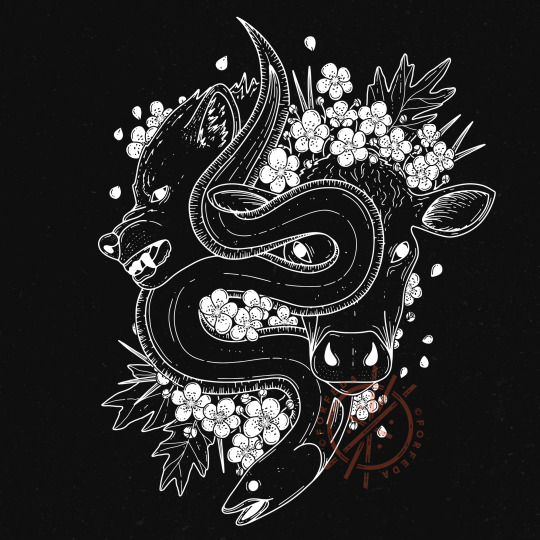
PHANTOM AT THE FORD
"I will come against you in the form of an eel about your feet in the ford, so that you shall fall… I will drive the cattle on the ford to you, in the form of a grey she-wolf… I will come to you in the form of a hornless red heifer before the cattle. They will rush on you on the plains and on the fords, and on the pools, and you will not see me before you…" - The Morrígan to Cú Chulainn, Táin Bó Cúailnge
In the Táin Bó Cúailnge ("the Cattle Raid of Cooley"), the warrior Cú Chulainn is able to stave off the advances of Queen Medb's army by invoking his right to single combat at the fords, singlehandedly defeating each of Medb's champions in turn. But when Cú Chulainn refuses help from the Morrígan, a powerful goddess, she resolves to instead be a hindrance to him, taking different animal forms to disrupt his battles - an eel to trip him, and a wolf and a heifer to drive the cattle over the ford.
This piece depicts the three forms of the Morrígan surrounded by the thorns and flowers of the hawthorn, a tree connected to terror, baneful magic, and the powers of the Otherworld in Gaelic folklore.
#celtic#celticart#mythology#irish mythology#celtic mythology#folklore#morrigan#cu chulainn#shapeshifter#tain bo cuailgne#ulster cycle#hawthorn#deity#gaelpol#pagan#pagan art#goddess#forfedaproject
211 notes
·
View notes
Text
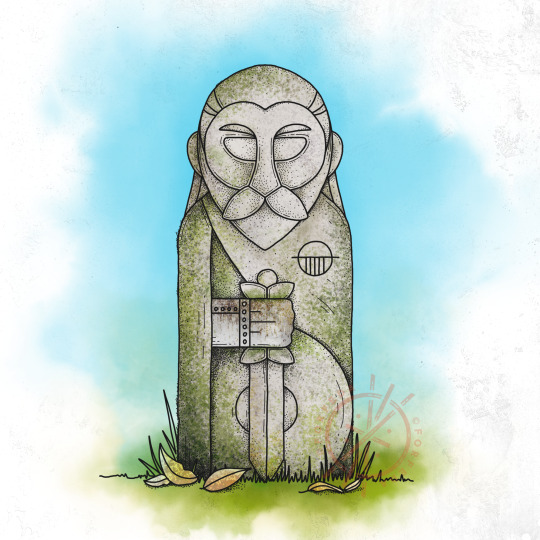
GODSTONES - NUADA
Nuada is portrayed in the lore as a noble king and warrior, who wields a magical sword and sacrifices both his hand and his kingship to aid the Tuatha Dé. He appears in such tales as The Fate of the Children of Tuireann and both Battles of Moytura. He may also be an ancestor of Fionn Mac Cumhaill, and may be related to (or identical with) Nechtan.
This is an art series depicting the Gaelic gods as ancient statues, with designs loosely inspired by historical finds, such as the Boa Island and Tandragee idols from Northern Ireland, and the Ballachulish Figure from Scotland. In this piece, Nuada is pictured with his signature sword and silver hand.
(I promise I'm not dead, just been busy! New stuff coming soon)
#celtic#celticart#mythology#irish mythology#celtic mythology#folklore#nuada#nuadu#airgetlam#silverhand#sword#nechtan#deity#gaelpol#pagan#pagan art#godstones#forfedaproject
178 notes
·
View notes
Text
It's that time of year again! Happy Samhain everyone
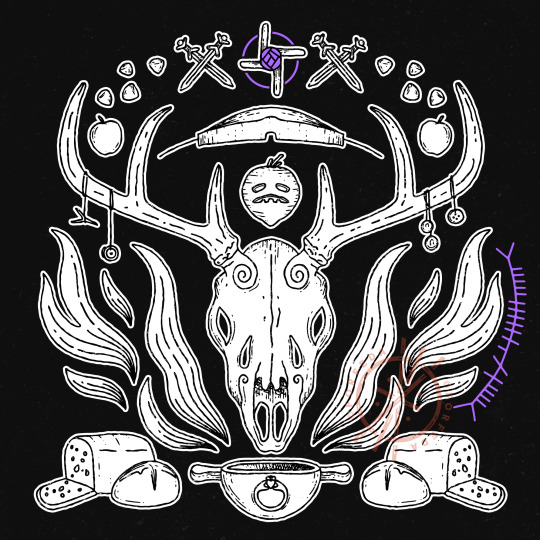
SAMHAIN
By far the best known Gaelic festival, Samhain marked the end of summer in Ireland, when assemblies were held and the cattle were brought to winter pastures. The traditional (though contested) date is usually given as November 1st, with festivities beginning at dusk on October 31st. Like with Bealtaine, the festival of Samhain is marked by bonfires and an emphasis on protection from Otherworldly forces. Syncretism with All Hallow's Eve resulted in many traditions involving the dead or the Daoine Sidhe roaming the lands on Samhain, looking to snatch away or otherwise harm those who did not observe the proper rites. As such, the wearing of disguises and the creation of charms were meant to ward away unwanted attention. Divination games were also common on Samhain, primarily concerning matters of love and marriage. Hiding trinkets such as coins or rings in plates of food and loaves of bread was the most popular method, although apples and hazelnuts were also employed. Samhain is also the setting for many of Irish mythology's most famous tales, especially stories of wooings and conceptions. Modern Scottish tradition associates Samhain with the Cailleach, the hag of winter, who rules over the colder months. The Brugh na Boinne was particularly associated with Samhain, and modern folklore describes it as the site of battles, feasts, and games carried out by the Daoine Sidhe on Samhain night. This piece features a deer skull to evoke the deer herd of the Cailleach and the traditions surrounding death, with crossed swords and the Brugh na Boinne for the Daoine Sidhe. Loaves of bannock and barmbrack, along with nuts and apples, encompass the culinary aspects of the holiday, and the quaich cup (a common sight at weddings) and divinatory trinkets hint at its more romantic overtones. Finally, bonfire flames, a carved tumshie lantern, and a parshell cross serve as charms to ward away Otherworldly dangers. Lá Fhéile Shamhna sona daoibh!
240 notes
·
View notes
Text
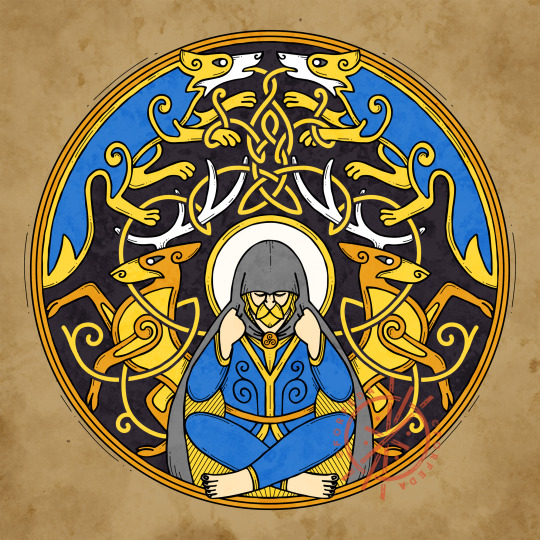
THE HOOD OF CROTHRAINNE
"Gold is its woof, silver underneath it, soft to the skin is its lining; you will be hound, man, or deer, as you turn it, as you change it." - A Rí Richid, Réidig Dam
The 12th Century poet Gilla in Chomded húa Cormaic is credited as the author of a poem known as A Rí Richid, Réidig Dam, which contains an episode involving the exploits of Fionn Mac Cumhaill and the Fianna. At the end of this episode, we are told of Fionn's most marvellous possession: the magical Hood of Crothrainne, a woven mantle fashioned in the Land of Promise that can change the wearer's shape. Any tales of Fionn using this power have been lost, but the significance of both hounds and deer to the Fenian cycle remains an ever-present motif.
#celtic#celticart#mythology#irish mythology#celtic mythology#folklore#fionn mac cumhaill#fionn#finn mccool#hood of crothrainne#book of kells#shapeshifting#celtic knot#knotwork#gaelpol#pagan#pagan art#forfedaproject
208 notes
·
View notes
Video
Appreciate the shoutout! 🙏
I never considered the possibility of the Morrígan having a Pogo Horse but now I can't get it out of my head lmao
youtube
My first medieval Irish video in wayyyy too long, featuring Cú Chulainn and the Morrígan having a disagreement about a cow. Wearing, of course, my @forfeda-project shirt, because what else could I wear for this particular video?
Links etc mentioned:
Bibliography for Táin Bó Regamna
Windisch’s edition
Leahy’s translation (Search for “Tain Bo Regamna” within the page.)
Cambrian Medieval Celtic Studies
Forfeda on Redbubble
Buy THE BUTTERFLY ASSASSIN!
And, finally, my tip jar.
142 notes
·
View notes
Text
shoutout to all the porn bots liking my posts 🙏 glad to see y'all like Irish mythology so much
15 notes
·
View notes
Text
Happy Lughnasa!
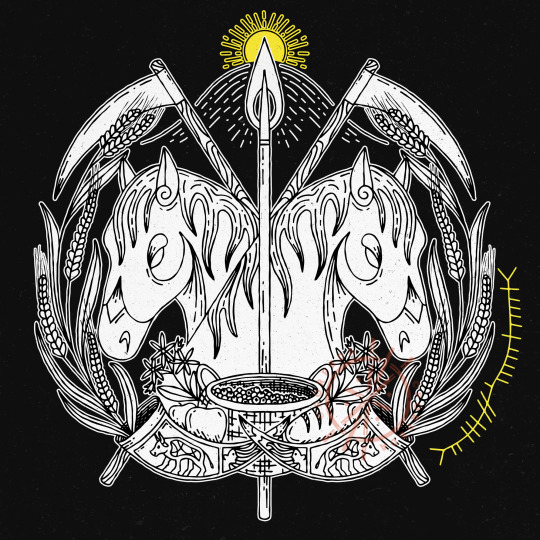
LUGHNASA
Also called Brón Trogain, the festival of Lughnasa is one of four major Irish festivals that shaped the Gaelic year. It signaled the beginning of the harvest season and maked the date for one of Ireland's most important assemblies.
Typically observed on August 1st, Lughnasa festivities saw the people gather on hilltops for a renewal of contracts, the paying of rents, the buying and selling of goods, and the holding of great feasts in celebration of the first fruits. Games and competitions of all kinds were also held, including horse racing and feats of strength.
According to Sanas Cormaic, the name "Lughnasa" is said to mean "The Assembly of Lugh," and the god has some strong associations with the day. In the Book of Invasions, we are told that Lugh inagurated the festival as a funeral games in memory of his foster mother Tailtiu, who died clearing the plains of Ireland. A running motif of both early and late accounts also have a light figure (usually St. Patrick, but most likely Lugh originally) in conflict with a darker agricultural figure named Crom Dubh, who is defeated. Surviving tales from Ireland and Scotland suggest that a bull (associated with Crom) may have been sacrificed and, in some accounts, revived in effigy as a feature of this motif.
This design features a depiction of two horses to represent the funeral games, along with scythes and a spear imposed over a hill to illustrate the motif of Lugh's triumph over Crom. The firstfruits of Ireland are also featured, in the form of stalks of barley, a basket of billberries, and wild garlic. Two drinking horns with reliefs of Tailtiu and of Crom as the sacrificial bull flank the bottom of the piece, representing both the plenty and feasting associated with Lughnasa, as well as a reminder of its darker and more sorrowful aspects.
Lá Fhéile Lughnasa sona daoibh!
221 notes
·
View notes
Text
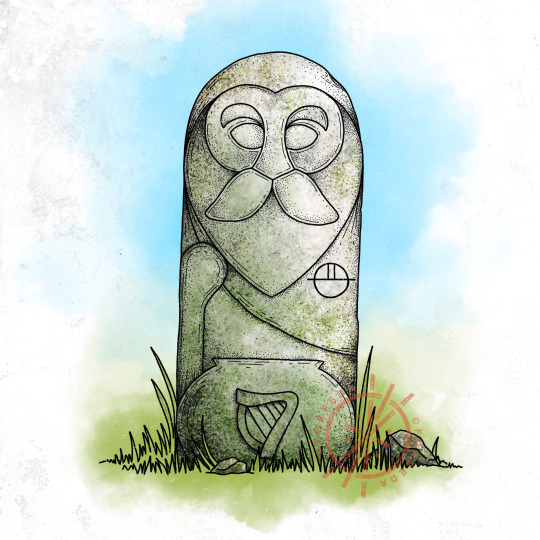
GODSTONES - THE DAGDA
The Dagda ("the good/capable god") is portrayed in the lore as a powerful warrior, a wise chieftain, and a shaper of the land, appearing in such tales as the Second Battle of Moytura, the Wooing of Étaín, and How The Dagda Got His Magic Staff. Known for his massive stature, lowly appearance, and his mastery over all the arts, the Dagda is one of the most important figures in the Mythological Cycle.
This is an art series depicting the Gaelic gods as ancient statues, with designs loosely inspired by historical finds, such as the Boa Island and Tandragee idols from Northern Ireland, and the Ballachulish Figure from Scotland. In this piece, the Dagda is pictured with his signature harp, club, and cauldron.
#celtic#celticart#mythology#irish mythology#celtic mythology#folklore#the dagda#dagda#ollathair#cauldron#harp#club#deity#gaelpol#pagan#pagan art#godstones#forfedaproject
576 notes
·
View notes
Text

"O grandson of Conn, O Cormac," said Carbre, "what were your habits when you were a lad?" "Not hard to tell," said Cormac. "I was a listener in woods, I was a gazer at stars, I was blind where secrets were concerned, I was silent in a wilderness…
~ Tecosca Cormaic
Tecosca Cormaic, or the Instructions of Cormac Mac Airt, is an Old Irish wisdom text where the legendary high king Cormac provides judgements and advice to his son Carbre on how to be a good man and a wise king. Upon being asked about his conduct as a young man, Cormac recounts, among other things, time spent in the woods and wilds of Ireland, saying "it is through these habits that the young become old and kingly warriors."
This piece is built around my favorite line from the Tecosca, and features far more knotwork than I ever want to draw again (but probaly will). Wanted to illustrate this quote for a while, so I'm very pleased with how it's turned out.
#celtic#celtic art#mythology#irish mythology#celtic mythology#folklore#cormac#cormac mac airt#tecosca cormaic#celtic knot#knotwork#druid#pagan#pagan art#gaelpol#artists on tumblr#forfedaproject
386 notes
·
View notes
Note
Yesss hit the nail on the head. The Book of Kells often puts these neat little outlines around its figures, and the fact that it ended up looking not unlike surgery scars was valuable and appropriate - but the ambiguity was very much intentional. I wanted people to be able to derive more than one meaning out of the image, just like how I want people to be able to derive more than one reading out of the character.
(But yes, this depiction of Cú is meant to be based specifically on a queer reading of the character, while leaving the type of queerness unspecified.)
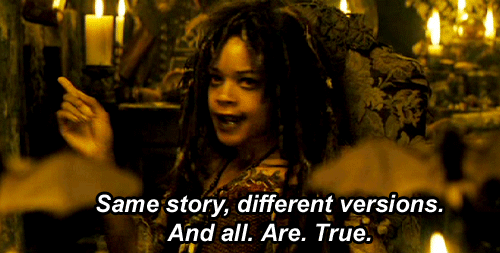
just saw that pride art of cu you ordered and I love that it kind of looks like he has too surgery scars? like trans cu for the win
Yes, I've always assumed that was deliberate, based on @forfeda-project's caption on the original piece -- his short stature, beardlessness, and exclusion from the category of "men of Ulster" are all elements which can contribute to trans readings, while other aspects (i.e. his deeply homoerotic relationships with Fer Diad and, not mentioned, with Láeg) can contribute to different queer readings. Though I also appreciate the ambiguity of the scar/line being the same colour as the outline -- just as we can explore different and even contradictory readings of the texts, so we can interpret the same image differently :)
(But since it is definitely Pride Cú -- the Ogham says bród -- I think it's safe to assume that this Cú is queer no matter the specifics of our interpretations.)
37 notes
·
View notes
Text
I aspire to one day have a Cú Chulainn wall. Thank you so much!
Guess who arrived this morning while I was working on my translation...
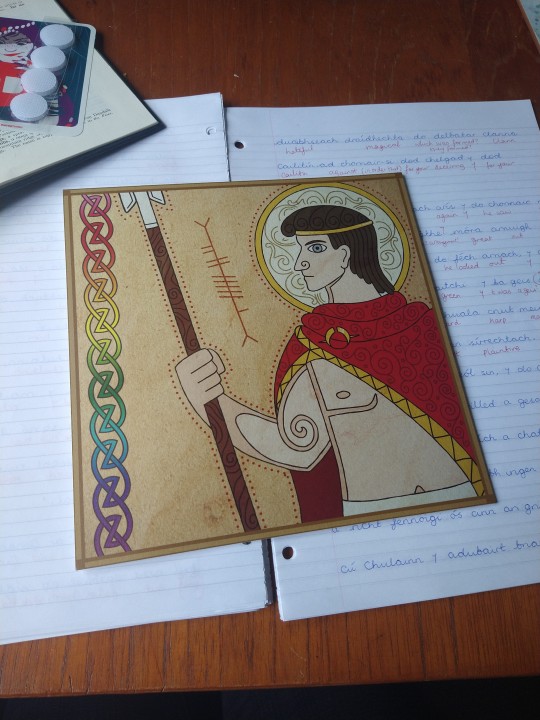
It's Him (@forfeda-project 's Pride Cú Chulainn).
A very welcome addition to the Cú Chulainn wall above my desk:
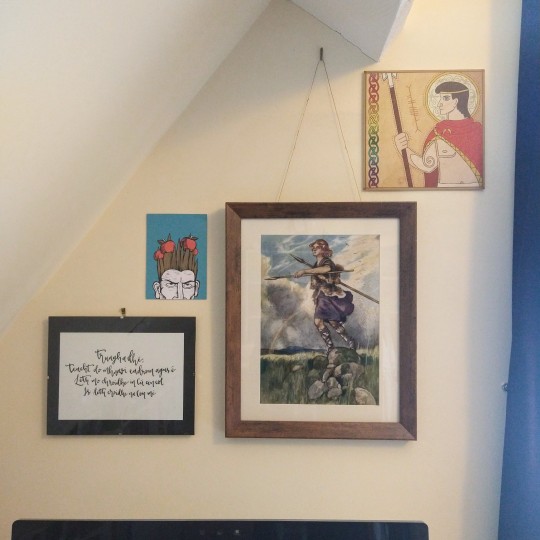
(Please forgive the rather disordered layout. With the sloped ceiling, beam, and existing picture hooks, a certain degree of chaos was inevitable.)
36 notes
·
View notes
Text

I have been freed from Shadowban Hell, praise be 🙏
12 notes
·
View notes